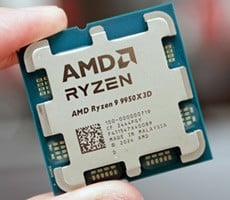SiFive HiFive Premier P550 Review: A True RISC-V Dev Kit Platform Emerges
SiFive HiFive Premier P550: Everything is Fine, Nothing Is Ruined
The HiFive Premier P550 was perfectly trouble-free until Ubuntu's automatic update utility prompted us to install about 1GB worth of updates. Our system's image was from the initial release in November, and we started testing in January, so it makes sense there would be updates. And even the update process itself seemingly went well, but then we were advised to reboot.The system initially appeared to boot like normal, but then would get stuck as it started the desktop environment. We never got to a login prompt and the mouse pointer was all that was on screen. We next booted to the command line and tried starting the X window system manually (startx at the command line) and got the same result. Obviously something in the update process didn't go very well. And now that we think about it, we probably should have just taken the Radeon out of the system to see if that would fix our boot problems. If we break it again, we'll try that first.
Since it was a relatively fresh installation, we didn't bother with too much troubleshooting. Instead, we looked up how to install the operating system. Armed with an ext4-formatted USB thumb drive containing the image, we restarted the system and interrupted the boot process to drop into the bootloader, where we could re-flash the image to the built-in eMMC storage. This was pretty straightforward and it only took about ten minutes to flash the image from our thumb drive to the eMMC, and we were back at our starting point. The whole process from finding the image to rebooting after re-flashing was under an hour.
At this point, we disabled all of Ubuntu's update services just to prevent this from happening again. It's worth noting that as of this writing, SiFive has an updated Ubuntu image available on GitHub from mid-February. While we'd already done our preliminary testing, we decided to wipe and re-flash the eMMC again just to see if there were any performance differences. Performance was basically unchanged from our previous findings, although we are reporting the performance of the latest version of the Ubuntu image from SiFive's GitHub here.
Quick Benchmarks On The SiFive HiFive Premier P550
It's totally fair game to benchmark what essentially amounts to a hardware validation platform like the SiFive HiFive Premier P550. It is, after all, a retail product that folks can buy and run for themeselves. However, it's probably a little unfair to compare it to any consumer-focused device on the market. But let's be real -- RISC-V doesn't exist in a vacuum and it will be compared to CPUs built on other RISC instruction set architectures, namely Arm64. By far the most popular Arm desktop series on the market is the Raspberry Pi 5 family, and we just happen to have a Raspberry Pi 5 with 8 GB of memory on hand.Benchmarks on Linux have come a long way, largely thanks to the Phoronix Test Suite. We ran the full Productivity benchmark battery on both the HiFive Premier P550 and the Raspberry Pi 5. We also have a handful of relevant compile time tests, and used the Geekbench 6.4 Preview for both Arm64 and RISC-V. But first, let's get some context for said results.
SiFive claims on the Performance P550 SoM product page that this RISC-V CPU should deliver 30% better performance than an Arm Cortex A75 in a smaller silicon area. We're making the assumption that the clocks are matched clock-for-clock. By Arm's own estimations, the Cortex A76 core found in the Raspberry Pi 5 is anywhere from 25% to 35% faster than the A75, which makes an eyeball comparison about equal footing for equal clock speed. Neither of these Arm CPU designs are exactly fresh, either; we're referring to an article from 2018 here.
However, clock speeds are not equal in this case. The Raspberry Pi 5 is clocked at 2.4 GHz on the CPU block while the Performance P550 processor has its CPU cores running at just 1.4 GHz. Results are going to not be particularly close here, since the Raspberry Pi 5 has a 71.4% clock speed advantage. Going into the tests, we already knew there would likely be instances where the RPi5 is going to be close to twice as fast as the Performance P550. And that's assuming a fully optimized RISC-V compiler that spits out code as efficient on RISC-V, as an Arm compiler does for its own platform. At least they're both quad-core designs, so they're working with the same number of threads.
So, the reality is that the Performance P550 design has some work cut out for it. First we did some light stretching with Geekbench 6.4.
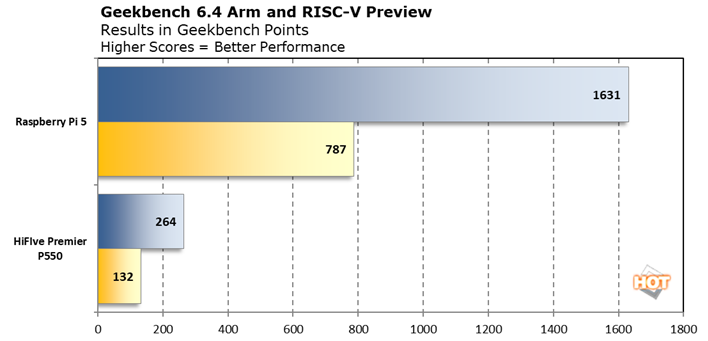
This kind of sets the stage for the rest of our tests. The Raspberry Pi 5 is quite a bit faster than the Premier P550, and both systems are only about 2x as fast in the multi-threaded tests than they were in single-threaded performance. Geekbench 6.4 does have a special version for RV64GCV cores, where the V is for vector SIMD instructions, with loads of enhancements. So there is room to grow, but the P550 does not support those SIMD instructions, and we believe performance suffers as a result.
Next up is the Phoronix Test Suite's Productivity benchmarks. Most of them use the GEGL image manipulation library, while a handful of others rely on other applications. Let's take a look.
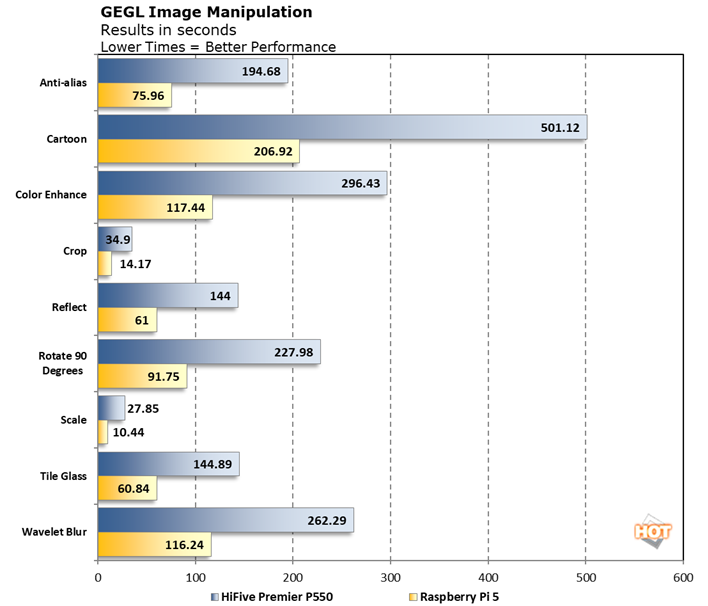
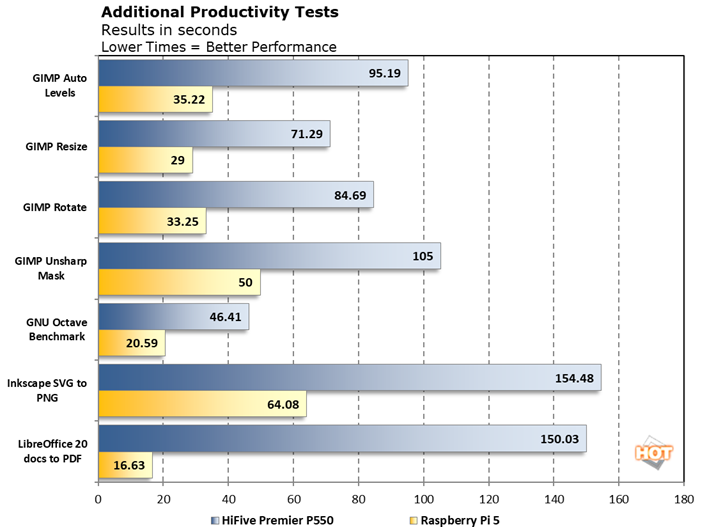
The results are kind of all over the map, but there was no instance in which the HiFive Premier P550 was even half as fast as the Raspberry Pi 5. The Pi 5 is, on average, about 2.5x as fast as the SiFive SoC, and now might be a good time to remind ourselves that this is a dev kit for testing RISC-V software, not a consumer-oriented PC.
Lastly, let's take a look at some project compile times. We chose the projects listed below as they are important to different areas of development. CPython is the Python language written in C, which is the default and most popular option for using the language, and it's incredibly important to AI development, as so many machine learning frameworks are built upon it. PHP is a very popular language focused on web development used in big name web applications like Wordpress. And finally, Ffmpeg is a library for media encoding and decoding.
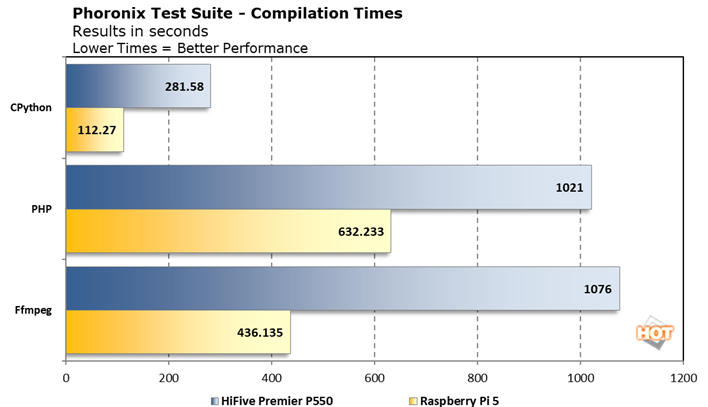
Finally, with the PHP compile test, do we see results approaching what we expected based on SiFive's comparisons to the Cortex A75 and the clock speed differences between the two systems. The Raspberry Pi 5 is still nearly 40% faster than the HiFive Premier P550, but that's what we started off expecting. The others are still show the Pi being more than twice as fast.
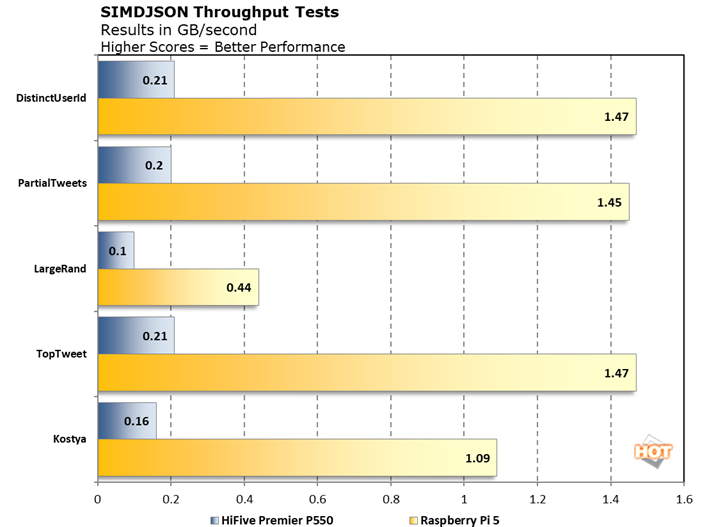
SIMDJSON is valuable for measuring the performance of web servers. This library is meant for processing JSON data (JavaScript Object Notation) which a is very common format for web applications to communicate with each other as well as between back-end server APIs and the front-ends which they support. Neither system here is super speedy, but the Raspberry Pi 5 again pulls ahead.
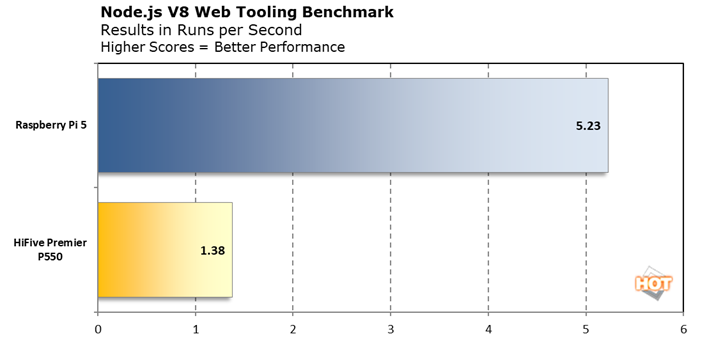
There's a big ray of sunshine here, though, in the fact that these tests ran at all. This means all of the dependencies these three projects rely upon have RISC-V binaries, which is a big step in the right direction. Previously, we struggled to test the performance of the legacy HiFive Unmatched board, due to the inability to build much software at all.
SiFive HiFive Premier P550 Developer Kit Conclusions
The SiFive HiFive Premier P550 is the first RISC-V development board that we tested which we found to be remotely usable as a client PC. A large amount of credit goes to the rapidly growing RISC-V ecosystem. For example, Mozilla Firefox on RISC-V is a relatively new development, as is Ubuntu Linux and all of its supporting software. However, SiFive and its partners have also made huge strides in CPU design performance.That said, it's going to take another large leap to make RISC-V remotely viable for mainstream PCs or other devices. The HiFive Premier P550 is not a consumer device. It's a development platform used to validate the nascent software platform that's springing up around the RISC-V ISA. Just the fact that hardware-accelerated graphics drivers exist for some AMD hardware is a step in the right direction. And to do that, we needed a device with a PCI Express slot to test it. This platform is a winner in its own right. The hardware is relatively affordable, too. $399 gets you the model with 16 GB of LPDDR5, while $499 bumps that to 32 GB. All of the other specs are the same.
So who should take interest in the SiFive Premier P550? If you're asking that question, the answer is that it's likely not for you. You'll know you're the target audience because you're either a huge nerd that wants to play with the latest flavors of alternative hardware, or you're a developer working hard on building the software and hardware ecosystem up around this relatively new open source technology. If that describes you, the SiFive HiFive Premier P550 is probably already calling your name. You've also probably already opened another browser tab to go pick one up. And for that reason, we're labeling it, HotHardware Approved.







